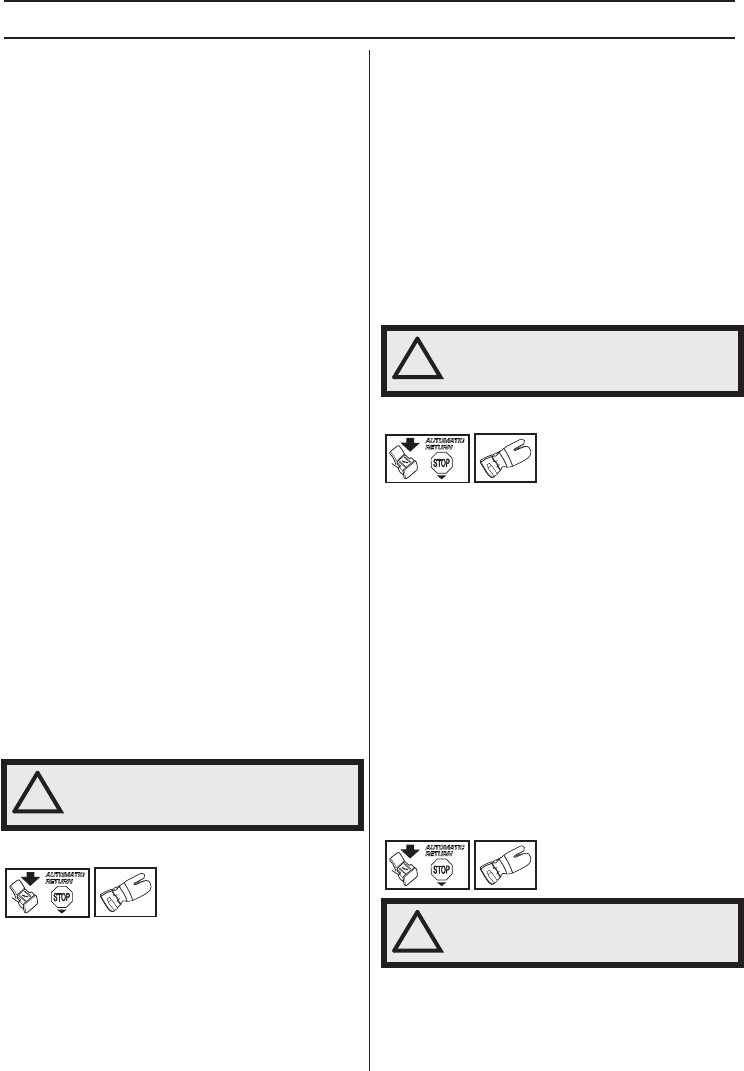
GENERAL SAFETY PRECAUTIONS
14 – English
1154580-38 Rev.1 2011-12-05
• Bar groove width (inches/mm). The groove in the bar
must match the width of the chain drive links.
• Chain oil hole and hole for chain tensioner. The bar
must be matched to the chain saw design.
(16)
Saw chain
• Chain pitch (inches) (15)
• Drive link width (mm/inches) (18)
• Number of drive links. (17)
Sharpening your chain and adjusting
depth gauge setting
General information on sharpening cutting teeth
• Never use a blunt chain. When the chain is blunt you
have to exert more pressure to force the bar through
the wood and the chips will be very small. If the chain
is very blunt it will produce wood powder and no chips
or shavings.
• A sharp chain eats its way through the wood and
produces long, thic
k chips or shavings.
• The cutting part of the chain is called the cutter and
consists of a cutting tooth (A) and the depth gauge
(B).
The cutters cutting depth is determined by the
difference in height between the two (depth gauge
setting).
(23)
When you sharpen a cutting tooth there are four important
factors to remember.
1 Filing angle (21)
2 Cutting angle (20)
3 File position (22)
4 Round file diameter
It is very difficult to sharpen a chain correctly without the
r
ight equipment. We recommend that you use our file
gauge. This will help you obtain the maximum kickback
reduction and cutting performance from your chain.
(22)
See instructions under the heading Technical data for
information about sharpening your chain.
Sharpening cutting teeth
To sharpen cutting teeth you will need a round file and a
file gauge. See instructions under the heading Technical
data for information on the size of file and gauge that are
recommended for the chain fitted to your chain saw.
• Check that the chain is correctly tensioned. A slack
chain will mo
ve sideways, making it more difficult to
sharpen correctly.
• Always file cutting teeth from the inside face. Reduce
the pressure on the retur
n stroke. File all the teeth on
one side first, then turn the chain saw over and file the
teeth on the other side.
• File all the teeth to the same length. When the length
of the cutting teeth is reduced to 4 mm (5/32") the
chain is w
orn out and should be replaced.
(23)
General advice on adjusting depth gauge setting
• When you sharpen the cutting tooth (A) the depth
gauge setting (C) will decrease. To maintain optimal
cutting performance the depth gauge (B) has to be
filed down to achieve the recommended depth gauge
setting. See instructions under the heading Technical
data to find the correct depth gauge setting for your
particular chain.
(24)
Adjustment of depth gauge setting
• The cutting teeth should be newly sharpened before
adjusting the depth gauge setting. We recommend
that you adjust the depth gauge setting every third
time you sharpen the cutting teeth. NOTE! This
recommendation assumes that the length of the
cutting teeth is not reduced excessively.
• You will need a flat file and a depth gauge tool. We
recommend that y
ou use our depth gauge tool to
acheive the correct depth gauge setting and bevel for
the depth gauge.
• Place the depth gauge tool over the chain. Detailed
inf
ormation regarding the use of the depth gauge tool,
will be found on the package for the depth gauge tool.
Use the flat file to file off the tip of the depth gauge that
protrudes through the depth gauge tool. The depth
gauge setting is correct when you no longer feel
resistance as you draw the file along the depth gauge
tool.
(24)
Tensioning the chain
The more you use a chain the longer it becomes. It is
therefore important to adjust the chain regularly to take up
the slack.
!
WARNING! Departure from the
sharpening instructions considerably
increases the risk of kickback.
!
WARNING! The risk of kickback is
increased if the depth gauge setting is
too large!
!
WARNING! A slack chain may jump off
and cause serious or even fatal injury.


















